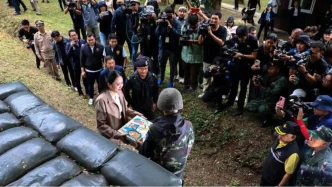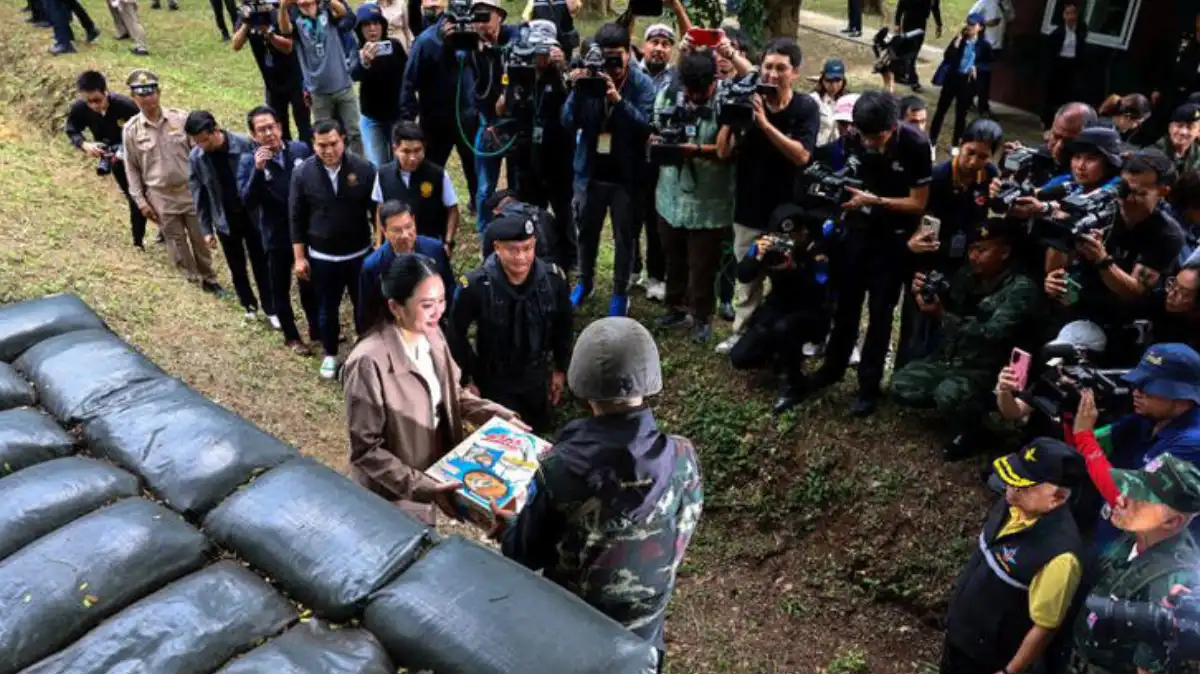High-ranking leaders from Thailand and Cambodia made near-simultaneous visits to their shared border on June 26, 2025, underscoring the escalating tensions in the region. Thai Prime Minister Paetongtarn Shinawatra inspected checkpoints and met with military personnel in Aranyaprathet, Sa Kaeo Province, while Cambodian Senate President and former Prime Minister Hun Sen engaged with armed forces in Oddar Meanchey and Preah Vihear provinces. These visits come amid reports of military buildups and a recent cross-border incident, raising concerns about the potential for a prolonged conflict.
Leaders on the Frontlines
On the Thai side, Prime Minister Paetongtarn Shinawatra’s itinerary was packed with engagements aimed at assessing the border situation. Departing from Bangkok early in the morning, she arrived at the 3rd Infantry Battalion in Aranyaprathet, where she chaired a meeting at Aranyaprathet School to discuss the impact of border restrictions. Her visit to the Ban Klong Luek Border Crossing included interactions with local residents and business operators, as well as encouragement to officers stationed there. Later, she met with military personnel at the 1202 Infantry Regiment in Pa Rai Village and connected with teachers and students at the Police Border Patrol School, before concluding her trip with administrative officers at Surasinghanart Fort.
Meanwhile, across the border, Hun Sen, now Senate President and a five-star General, conducted inspections of Cambodian forces. Starting his day in Samrong City, Oddar Meanchey Province, he met with commanders at the 3rd Regional Command Headquarters. In a significant development, Hun Sen announced via his official Facebook page that he had accepted a request from military commanders to take on the role of Chief of Staff of the Armed Forces. His spokesperson, Chhea Thirith, emphasized that this decision reflects Hun Sen’s commitment to supporting the military, particularly in ensuring supplies for troops stationed at the border.
Hun Sen’s tour continued with visits to military personnel in Oddar Meanchey, where he assessed their readiness, and later to Preah Vihear Province. His public statements highlighted the importance of strong leadership in protecting Cambodia’s borders, especially in light of recent tensions with Thailand.
Roots of the Conflict
The current strain between Thailand and Cambodia follows a reported cross-border attack by Thai forces on May 28, 2025, according to Cambodian sources. In response, Cambodian authorities have deployed armed forces equipped with modern weaponry to border areas in Oddar Meanchey and Preah Vihear provinces. Thailand, for its part, has imposed border closures, though it has allowed limited crossings under humanitarian measures—up to 1,000 Cambodians per day at Ban Khlong Luek, as per the Thai First Army Area directives.
During a meeting with local councils in Oddar Meanchey, Hun Sen acknowledged the political frictions driving the standoff. He urged communities to bolster agricultural production and self-reliance, framing the crisis as a potential catalyst for innovation. At the same time, he called on citizens to support the military in maintaining security, warning that the conflict could escalate into a prolonged struggle, distinct from the shorter-lived 2011 border disputes over the Preah Vihear Temple, a UNESCO World Heritage site that has long been a flashpoint between the two nations.
Hun Sen also pointed to Thailand’s unilateral border closure as a complicating factor, noting that Bangkok later sought negotiations to reopen crossings. He further contextualized Thailand’s border challenges by referencing similar issues with Myanmar, Laos, and Malaysia, suggesting a broader pattern of regional friction.
Humanitarian and Economic Impacts
The border restrictions have had immediate effects on communities on both sides. In Thailand’s Sa Kaeo Province, tensions have flared as Cambodians attempt to return home, with Thai authorities working to manage the situation. The limited daily crossings permitted under humanitarian measures have provided some relief, but local businesses and residents near checkpoints like Ban Klong Luek are grappling with reduced trade and mobility. During her visit, Paetongtarn Shinawatra heard firsthand from affected operators about the economic toll of the closures.
In Cambodia, Hun Sen’s call for agricultural self-reliance reflects an awareness of the potential long-term disruptions caused by restricted border access. Many border communities rely on cross-border trade for goods and income, and a sustained closure could exacerbate economic hardship. The Cambodian leader’s emphasis on supporting military efforts while promoting local production suggests a dual strategy of defense and domestic resilience.
Political Dynamics and Regional Implications
The near-simultaneous border visits by Paetongtarn and Hun Sen are not merely symbolic; they reflect deeper political currents in both countries. For Thailand, Paetongtarn’s presence at the border signals a hands-on approach to national security amid domestic scrutiny of her administration’s handling of foreign relations. Thailand’s political landscape remains volatile, with frequent shifts in power and ongoing tensions with multiple neighbors. Cambodian Prime Minister Hun Manet, Hun Sen’s son and successor, has publicly attributed barriers to a border solution to Thai political instability, suggesting that uncertainty over who holds “real power” in Bangkok complicates negotiations.
On the Cambodian side, Hun Sen’s return to a prominent military role as Chief of Staff, alongside his positions as Senate President and former Prime Minister, reinforces his enduring influence over the country’s direction. His warnings of a prolonged conflict may serve both as a rallying cry for national unity and a strategic message to Thailand and the international community about Cambodia’s readiness to defend its sovereignty.
Historically, the Thai-Cambodian border has been a site of recurring disputes, often centered on territorial claims like those surrounding Preah Vihear Temple. The 2011 clashes, which resulted in casualties on both sides, were eventually de-escalated through international mediation, including involvement from the International Court of Justice, which reaffirmed Cambodia’s claim to the temple in 2013. However, underlying issues of border demarcation and nationalist sentiments continue to fuel mistrust.
Voices from the Ground
Public sentiment, as gauged from social media posts and local reports, reveals a mix of anxiety and resolve. On platforms like X, users near the border express concern over the military buildup, with some Cambodians praising Hun Sen’s leadership while others worry about the economic fallout of a closed border. In Thailand, opinions are similarly divided, with residents near Sa Kaeo calling for a swift resolution while acknowledging the need for strong border security.
Local leaders in both countries face the challenge of balancing community needs with national directives. Hun Sen’s engagement with commune and district councils in Oddar Meanchey aimed to align local governance with military priorities, while Paetongtarn’s interactions with students and teachers in Pa Rai Subdistrict underscored the broader societal impacts of the crisis.
Looking Ahead: Peace or Prolonged Conflict?
As military presence grows on both sides of the Thai-Cambodian border, the risk of escalation looms large. Hun Sen’s public statements, while reiterating a desire for peaceful and cooperative borders, carry an undercurrent of preparedness for a drawn-out struggle. His reference to the 2011 conflict as a less severe precedent suggests a belief that current tensions could prove more intractable if not addressed through dialogue.
Thailand’s allowance of limited humanitarian crossings indicates a willingness to mitigate civilian hardship, but the broader closure policy reflects a firm stance on security. With both leaders visibly prioritizing border oversight, the coming weeks will test whether diplomatic channels can prevent a slide into deeper conflict. Regional observers note that ASEAN, the Association of Southeast Asian Nations, may play a critical role in facilitating talks, given its history of mediating intra-regional disputes.
For now, communities along the border brace for uncertainty, caught between the imperatives of national defense and the everyday realities of disrupted trade and travel. As Paetongtarn and Hun Sen return to their capitals, the question remains whether their visits will mark the beginning of de-escalation or a prelude to a more entrenched standoff.















